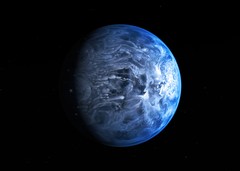Podcaster: Pamela Quevillon
Title: The Other Blue Planet!
Organization: Speak Easy Narration
Link : http://speakeasynarration.com ; http://www.unawe.org/kids/unawe1348/
Description: Space scoop, news for children. Imagine you’re in a spaceship, looking for a new world to settle down in. You see a planet in the distance and it’s a beautiful blue colour, just like Earth when it’s seen from space.
Bio: Pamela Quevillon is a voice actress who most often lends her voice to science and science fiction content. You can find her work on the “Escape Pod” and “365 Days of Astronomy”, as well as on her site
Today’s sponsor: This episode of “365 Days of Astronomy” is sponsored by — David Wallace Witmore
Transcript:

Hello and welcome to Space Scoop, a product of “Universe Awareness.” Our goal is to inspire every child with out wonderful cosmos.
Today we bring you a double feature, discussing an alien world that has been described as both the other blue planet and as a Great Ball of fire!
The Other Blue Planet & Goodness Gracious, Great Ball of Fire!
Earth is known as the ‘blue planet’ because of the vast oceans that cover two-thirds of its surface. When seen from space, our world looks like a pale blue dot. You might even have seen either the picture of Earth taken in 1990 by the Voyager 1 spacecraft or the July 19 image taken from the Cassini Space Craft. Now, for the first time ever, astronomers have uncovered the colour of a planet orbiting a distant star—and it’s blue, too!
Imagine you’re in a spaceship, looking for a new world to settle down in. You see a planet in the distance and it’s a beautiful blue colour, just like Earth when it’s seen from space. This planet is called HD 189733, and it is the first planet outside of our own Solar System that we’ve worked out the colour of!
As of today, 925 planets have been discovered orbiting around other stars in our Galaxy. But they’re very small and dim, so it’s not very often that we can actually see the planets. Most of the time we have to detect them using nifty tricks instead. One method is called the ‘Transit Method’. We point our telescope at a star, and wait to see if it gets any dimmer. If the star does get dimmer, it means that a planet is passing in front of it and blocking some of the light. With HD 189733, astronomers have looked at the system using the Chandra X-ray Telescope to find the dip in the amount of X-rays when the planet passes in front of the star.
The blue color of HD 189733 is where its similarities with Earth ends. The new world, or the ‘deep blue dot’, is an enormous gas giant, similar in size to Jupiter, the largest planet in our Solar System. It orbits very close to its star. It takes Earth 365 days to orbit our Sun once, but it only takes this planet 2.2 days! In fact, it’s so close to its star that temperatures in its atmosphere reaches over 1000°C! No amount of sun lotion or ice cream would make this a nice place to visit! You might wonder how blue oceans can survive in this extreme environment. Well, unlike Earth, it isn’t water that gives this world its lush blue colour. Its atmosphere is filled with something similar to glass particles, called ‘silicates’, which sparkle blue.
To make the environment there even less like Earth’s, it rains glass on this planet! And the glassy rain comes down in sideways torrents, blown by howling winds moving at 7000 km per hour! While the words ‘pale blue dot’ make us think of calm, tropical waters and light summer rain, this ‘deep blue dot’ is all sharp, raging storms and boiling heat. The boiling heat of its parent star is roasting away huge amounts of the planet’s air – up to 600 million kilograms every second!
Cool Fact
It turns out that HD 189733 has company! Astronomers have spotted a faint red star orbiting the parent star of HD 189733. You can see it at the bottom right of the picture. It takes about 3,200 years for this little star to complete one orbit — it’s like the planet’s slow-moving big brother!
This has been you weekly dose of Space Scoop.
365 Days of Astronomy is a community podcast made possible thanks to the contributions of people like you. Please consider donating at 365DaysofAstronomy.org/Donate
End of podcast:
365 Days of Astronomy
=====================
The 365 Days of Astronomy Podcast is produced by the New Media Working Group of the International Year of Astronomy 2009. Audio post-production by Preston Gibson. Bandwidth donated by libsyn.com and wizzard media. Web design by Clockwork Active Media Systems. You may reproduce and distribute this audio for non-commercial purposes. Please consider supporting the podcast with a few dollars (or Euros!). Visit us on the web at 365DaysOfAstronomy.org or email us at info@365DaysOfAstronomy.org. In the new year the 365 Days of Astronomy project will be something different than before….Until then…goodbye.


